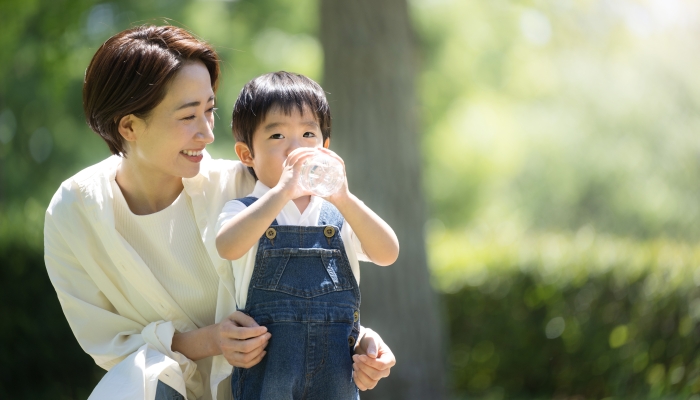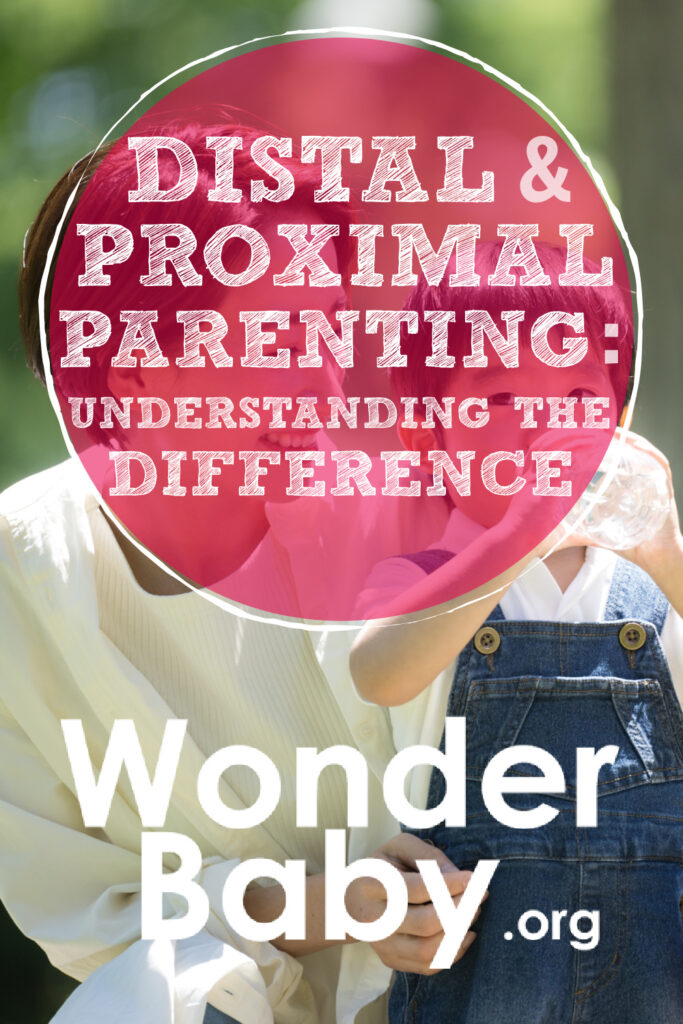Distal and Proximal Parenting: Understanding the Difference

- Distal parenting involves parenting from a distance using face-to-face communication and objects to interact.
- Proximal parenting is a significant amount of holding and close body contact between caregiver and child.
- There are pros and cons to both proximal and distal parenting styles.
- Understanding the difference between proximal and distal parenting will help you decide which parenting approach is best for your family.
There are so many different parenting approaches. From gentle parenting to Montessori parenting, it can feel overwhelming as a parent to decide which approach is best for your family. As a parent coach, I often consult with families striving to do what is best for their children.
There is no one-size-fits-all approach to parenting. Instead, we are fortunate to have lots of research and information about different styles to make an informed decision about what parenting approaches produce the best outcomes for children.
Parenting styles evolve as we continue to grow and learn more from research. Newer parenting styles like free-range or helicopter parenting have evolved from previous styles like proximal and distal parenting.
Understanding the history, differences, and strengths of proximal and distal parenting will help you decide what parenting approaches work best for your family.
What Is Distal Parenting?

The best way to define distal parenting is by thinking of distance. There is a larger space between the parent and the child in this parenting style.
Another way to understand distal parenting is to understand it culturally. Research shows that distal parenting occurs in more urban, modern, middle-class western culture families.
When families started to hire nannies to care for their children, there was a larger distance between the child and parent. Parenting by mom and dad in these households occurs at scheduled, short periods, sometimes only once daily.
This parenting style was coined ‘distal parenting’ due to the distance between the caregiver and the child.
Key Characteristics of Distal Parenting

According to a cross-cultural study in 200911. Keller, H., Borke, J., Staufenbiel, T., Yovsi, R. D., Abels, M., Papaligoura, Z., Jensen, H., Lohaus, A., Chaudhary, N., Lo, W., & Su, Y.. Distal and proximal parenting as alternative parenting strategies during infants’ early months of life: A cross-cultural study. International Journal of Behavioral Development. 2009;33(5), 412–420. https://doi.org/10.1177/0165025409338441 in the International Journal of Behavioral Development, distal parenting combines face-to-face interactions and object stimulation with limited body contact.
Parents use objects, like toys, to interact with children. There is an emphasis on cognitive development and increased eye contact.
The distal parenting style typically includes other influential caregivers, not just the mother. As babies grow, distal parenting encourages the child to explore their environment, leading to more independence and autonomy.
Pros and Cons of Distal Parenting

Those who support distal parenting say this parenting style produces an autonomous, independent child. A child’s independence can grow when they are encouraged to move further from their parents to explore.
Proponents of distal parenting feel that children are more curious and engaged in their surroundings because they are given more opportunities to explore.
The increased eye contact associated with distal parenting can also benefit healthy brain development. According to a 2002 study on eye contact detection in humans from birth22. Farroni, T., Csibra, G., Simion, F., & Johnson, M. H.. Eye contact detection in humans from birth. Proceedings of the National Academy of Sciences. 2002;99(14), 9602–9605. https://doi.org/10.1073/pnas.152159999 published in Proceedings of the National Academy of Sciences, early eye contact with infants is a major foundation for later social skill development. Since distal parenting focuses on face-to-face interactions, this can positively impact a child’s brain development.
Opponents of distal parenting argue that increased eye contact from a distance is not beneficial for newborns due to their limited visual acuity. This means that a newborn’s vision is very blurry in the first few months of life. Newborns would struggle to see direct eye contact if parenting at a distance.
According to a study in the Journal of Applied Developmental Psychology33. Peláez-Nogueras, M., Gewirtz, J. L., Field, T., Cigales, M., Malphurs, J., Clasky, S., & Sanchez, A.. Infants’ preference for touch stimulation in face-to-face interactions. Journal of Applied Developmental Psychology. 1996;17(2), 199–213. https://doi.org/10.1016/s0193-3973(96)90025-8, infants responded more frequently to eye contact during parent-infant interaction when touched. Physical contact increases a baby’s ability to focus with eye contact. Since distal parenting is done at a distance, opponents of this parenting style do not think the increased eye contact is beneficial for a young child.
What Is Proximal Parenting?

Proximal parenting, on the other hand, involves close body contact. The proximal parenting style originated in rural, low-educated farming families. While the father left for work, the mother worked at home while carrying the baby in an infant sling.
Like the word ‘proximity,’ the proximal parenting style includes a significant amount of mother and baby being close together. In this parenting style, the mother is seldom apart from the baby.
Key Characteristics of Proximal Parenting

Common characteristics of proximal parenting include:
- Close physical contact between caregiver and infant’s body
- Mother as the primary caregiver
- Infant massage
- Breastfeeding for an extended period
- Co-sleeping
- Holding or sitting with a child on the lap or within proximity (within arm’s reach)
Pros and Cons of Proximal Parenting

Proponents of proximal parenting state that the baby’s closeness to the mother supports the infant’s early development. Being close to the baby enables the mother to be attuned to the baby’s needs. This can create a sense of calm and self-regulation.
Proximal parenting also impacts the child’s emotional development. This closeness enables the mom to perceive the baby’s needs faster and increases communication in the parent-child interaction.
Some believe that proximal parenting creates more self-aware children. Children feel safe and secure with their mother nearby and therefore can self-regulate and have increased self-recognition.
The baby’s proximity to the mother’s body heat can also impact the baby’s health. The mother can help the baby regulate temperature, thus reducing stress and reducing illness. Proponents of proximal parenting feel it helps children to be more physically healthy.
Opponents of proximal parenting believe that it is too restrictive and impedes a child’s ability to explore. Instead of creating independent children, this closeness might create dependent children who may struggle in early childhood education when separated from their mothers.
The prolonged attachment to the mother decreases the child’s ability to form other attachments, thus impacting development. There are concerns that proximal parenting can lead to helicopter parenting, a type of over-parenting. Helicopter parenting involves the mother constantly hovering near the child, impeding curiosity and growth.
How to Determine Which Parenting Approach Is Right for Your Child

There are so many different types of parenting approaches that it can feel overwhelming to decide which is best for your family. Many approaches to parenting align with the top four types of parenting styles: authoritative, permissive, neglectful, and authoritarian.
Out of the four main parenting styles, child psychologists endorse the authoritative parenting style as the best outcome for child development and children’s behavior.
The proximal and distal parenting styles both have strengths for producing a developmentally healthy child. You must decide what parenting approach fits best for your family. Some things to consider include:
- Your child’s personality
- Your personality
- Your family’s values
Understanding the differences between proximal and distal parenting can help you make a better-informed decision about what is best for your family.
Combining Approaches
If proximal and distal parenting styles feel uncomfortable in your family, consider a combination of both. Some suggest a mixture of both parenting styles, giving children distance at times and proximity at others.
Children need consistency. It’s regulating to know what to expect. And children also need some flexibility. Parenting styles don’t have to be rigid. Take cues from your child, their development, and your family values to decide which parts of each approach you like and would like to incorporate into your family.
References
- Keller, H., Borke, J., Staufenbiel, T., Yovsi, R. D., Abels, M., Papaligoura, Z., Jensen, H., Lohaus, A., Chaudhary, N., Lo, W., & Su, Y. (2009). Distal and proximal parenting as alternative parenting strategies during infants’ early months of life: A cross-cultural study. International Journal of Behavioral Development, 33(5), 412–420. https://doi.org/10.1177/0165025409338441
- Farroni, T., Csibra, G., Simion, F., & Johnson, M. H. (2002). Eye contact detection in humans from birth. Proceedings of the National Academy of Sciences, 99(14), 9602–9605. https://doi.org/10.1073/pnas.152159999
- Peláez-Nogueras, M., Gewirtz, J. L., Field, T., Cigales, M., Malphurs, J., Clasky, S., & Sanchez, A. (1996). Infants’ preference for touch stimulation in face-to-face interactions. Journal of Applied Developmental Psychology, 17(2), 199–213. https://doi.org/10.1016/s0193-3973(96)90025-8

Related Posts

Parenting
Sensory Wall Art: 5 Tips to Create a Room Your Blind or Low-Vision Child Will Love
Even if your child can’t see their surroundings, personalizing and decorating their room with thoughtful, sensory-friendly design can make a big difference in their confidence, independence, and joy.

Development, Special Needs
How to Track Milestones for Developmentally Delayed Babies
Parents of developmentally delayed babies can explore practical tools and strategies to track milestones, celebrate progress, and support their child’s unique developmental journey.

Fine and Gross Motor
5 Alternatives to Tummy Time for Babies with Motor Development Challenges
Does your baby struggle with tummy time due to motor development challenges? These alternatives to tummy time will offer the same benefits.